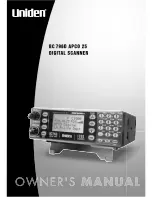
15
UNDERSTANDING BANKS AND BANDS
You can store frequencies into either
a permanent memory location called a
channel, or a temporary memory loca-
tion called a monitor memory. You can
store up to 90 channels and up to 3
monitor memories.
Your scanner also has eight frequency
bands, each covering a specific range
of frequencies you can search.
CHANNEL-STORAGE
BANKS
To make it easier to identify and select
the frequencies you want to listen to,
the scanner’s channels are divided
into 3 channel-storage banks (1–3) of
30 channels each. You can use each
channel-storage bank to group fre-
quencies, such as those used by the
police department, fire department,
ambulance services, and amateur ra-
dio operators (see “Guide to the Ac-
tion Bands” on Page 28).
For example, there might be three or
four police departments in your area,
each using several different frequen-
cies. Additionally, there might be other
law enforcement agencies such as
state police, county sheriffs, or SWAT
teams that use their own frequencies.
You could program all law enforce-
ment frequencies starting with Chan-
nel 1 (the first channel in Bank 1), then
program the fire department, para-
medic, and other public safety fre-
quencies starting with Channel 31 (the
first channel in Bank 2).
MONITOR MEMORIES
Monitor memories are temporary stor-
age areas where you can store up to
three frequencies during a search
while you decide whether to save
them into channels. You can manually
select and listen to monitor memories.
FREQUENCY BANDS
Your scanner has eight frequency
bands, each covering a specific range
of frequencies. You can search these
bands for specific broadcasts by re-
peatedly pressing
BAND
until the
scanner displays the band you want.
For example, you can search through
all frequencies between 29.000 and
54.000 MHz for specific broadcasts by
repeatedly pressing
BAND
until
29-
54
appears on the display. The scan-
ner then automatically searches the
frequencies in that band.
20-419.fm Page 15 Wednesday, March 24, 1999 2:43 PM
















































